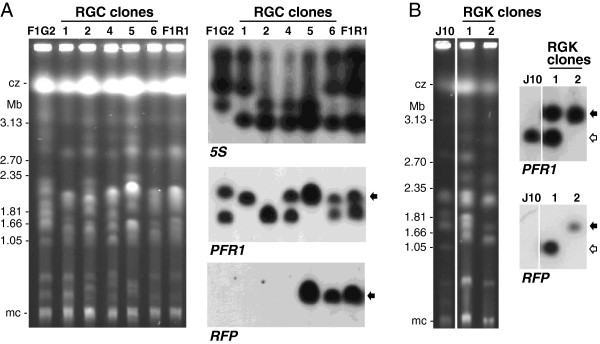Figure 3.

Molecular karyotypes of progeny clones. A. Ethidium bromide stained gel comparing the molecular karyotypes of clones from cross C (F1G2 x F1R1). Size marker: chromosomal DNA from Hansenula wingei; cz = compression zone, a region of the gel where several large chromosomal bands are trapped; mc = minichromosomes of approx. 100 kb in size. Clones 1, 2, 4 and 5 are hybrid, while clone 6 has a karyotype identical to that of parent F1R1. Other panels show autoradiographs following hybridization with the probes indicated. All blots were washed to 0.1 × SSC at 65°C. The arrows indicate the chromosome III homologue that carries both the PFR1 and RFP genes. B. Ethidium bromide stained gel comparing the molecular karyotypes of clones from cross K (J10 x F1R2). Clone 1 has an identical karyotype to F1R2 (not shown), while clone 2 has a different karyotype to both F1R2 and J10. The other panels show autoradiographs following hybridization with the probes indicated. PFR1 hybridization reveals that clone 1 and F1R2 (not shown) have chromosome III homologues of different sizes, whereas in clone 2 the bands co-migrate. The arrows indicate the chromosome III homologue that carries both the PFR1 and RFP genes in clone 1 (clear arrow) and clone 2 (filled arrow). Clone 2 had only genetic input from F1R2 and is a selfer.
